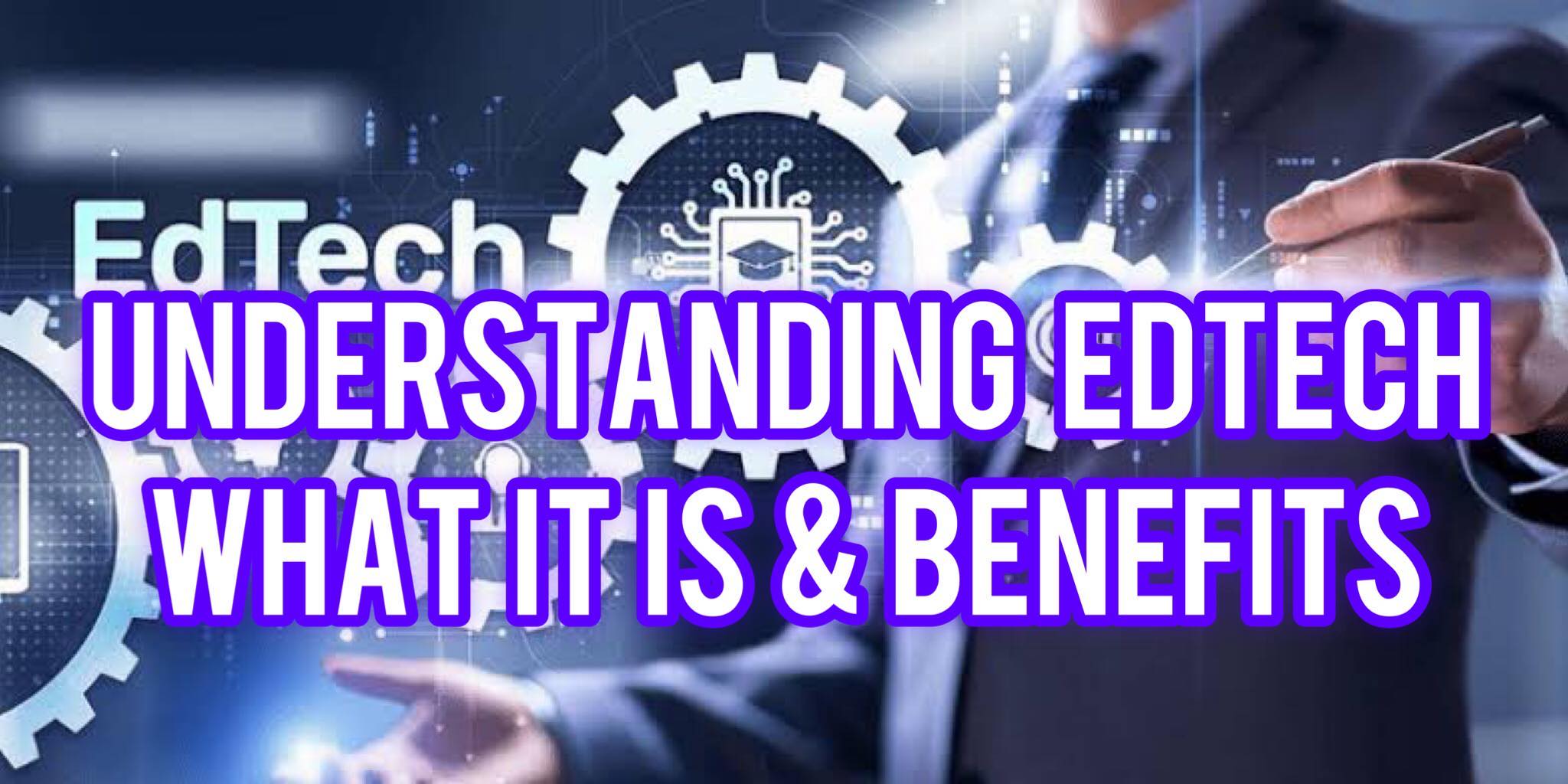The integration of IT technologies and educational methods known as “EdTech,” or education technology, is intended to facilitate and improve learning.
What IS EdTech?
The practice of using information and communication technology tools in the classroom to provide more interactive, inclusive, and personalized learning experiences is known as “EdTech,” or education technology.
Tablets, interactive online courses, and even robots that can take notes and record lectures for absent students are already commonplace in today’s classrooms, which have evolved beyond the cumbersome desktop PCs that were previously the standard.
Many changes are being made in classrooms as a result of the advent of EdTech tools. For instance, EdTech tools like robotics, virtual reality lectures, and gamified classroom exercises help students stay interested in their studies. And EdTech IoT devices are praised for their capacity to give students access to digital classrooms whether they are present in a traditional classroom, on a bus, or at home. Even blockchain and machine learning techniques are helping teachers grade exams and hold pupils accountable for their homework.
The possibility for scalable, personalised learning has been a major factor in the growth of the edtech sector. There is no one-size-fits-all approach to how we study, connect with with peers and professors, or feel about the same subjects in general. Everybody picks up information at their own rate and in their own way. No of the age or level of learning, edtech solutions make it simpler for teachers to develop personalized lesson plans and learning experiences that promote inclusion and improve the learning skills of all students.
And it appears that technology in the classroom will remain. In a 2018 research, 86% of eighth-grade instructors felt that it is crucial to use technology to educate kids. Yet according to 75% of the study’s teachers, using technology helped pupils’ academic achievement. Many would contend that it is crucial to comprehend the advantages that edtech delivers in the form of improved communication, cooperation, and educational quality overall. Learn more.
Advantages Of EdTech
This include different ways by which edtech can help students and teachers.
Advantages of EdTech for Students
Technology is expanding learning opportunities for students of all ages and encouraging diversity and collaboration in the classroom. Here are five significant ways that edtech is already changing how kids learn.
Increased Collaboration
Collaboration in the classroom is being facilitated by tablets and cloud-enabled applications. Children are given the means to collaborate on problems by using tablets that are loaded with educational games and online lessons. Cloud-based apps, however, allow students to upload their assignments and communicate virtually with one another about their ideas and any needed assistance.
24/7 Access to Learning
Students are finding it simpler to have full access to the classroom in a digital setting thanks to IoT devices. Students now have access to Wi-Fi and the cloud from connected devices whether they are at school, on the bus, or at home, enabling them to complete assignments at their own pace and according to their own schedules without being constrained by the requirement of being present in a physical classroom.
Different apps also assist students and teachers in staying in touch in case of inquiries or the need for pupils to notify teachers of an emergency.
“Flipping” the Classroom
The traditional idea of classrooms and education is being turned on its head by edtech technologies. Students typically study or listen to lectures in class before working on assignments and homework at home. With the use of learning apps and video lectures, students may now watch lessons at home at their own pace, utilizing class time for group collaboration on projects. This kind of learning environment encourages kids to learn for themselves, be creative, and work together.
Personalized Educational Experiences
Edtech gives teachers the chance to create individualized lesson plans for each of their students. Using this method, learning is supposed to be tailored to a student’s interests, talents, and strengths.
Because they may pause and rewind lectures, video content tools allow students to learn at their own pace and ensure that they understand the material being covered. Analytics allow teachers to identify which students struggled with particular lessons and provide further assistance.
Teachers are now using applications that reliably assess general aptitude in place of testing that causes anxiety to gauge academic performance. Continuous measurements reveal learning patterns that teachers can utilize to create customized lesson plans depending on each student’s strengths and limitations or, more crucially, to spot unfavorable patterns that can be proactively reversed with intervention.
Attention-Grabbing Lessons
Do you have any experiences of daydreaming while in class while partially listening? Given that there are so many devices and outside factors competing for a student’s attention, it’s critical to create lesson plans that are both engaging and instructive. Technology is the solution, according to edtech advocates. Some of the more creative ways that students are use technology to increase classroom engagement include videoconferencing with other classes around the world, having students submit their schoolwork as podcasts or films, and even gamifying problem-solving.
Also Read: Is EdTech A Good Career Path?
Advantages of EdTech for Teachers
The advantages of edtech extend beyond students. Technology in education is being viewed by teachers as a way to create effective teaching strategies and reduce class time. These are four ways that edtech is assisting teachers in getting back to what they do best (teaching).
Automated Grading
Using edtech tools with artificial intelligence makes grading simple. These programs analyze and rank responses in accordance with the requirements of the task using machine learning. Hours that teachers would often spend grading assignments can be saved by using these tools, especially for objective tasks like true/false or fill-in-the-blank tests. Additional time off allows teachers more freedom for less preparation and one-on-one interaction with both gifted and struggling pupils.
Classroom Management Tools
Let’s face it: it can be difficult to persuade a large group of children to do anything. The use of educational technology has the ability to make everything a little bit simpler, from how teachers interact with their pupils to how students behave. There are now tools that enable students to self-monitor classroom noise levels, as well as apps that help send parents and students reminders about projects or homework assignments. An environment that is less chaotic and more collaborative results from the integration of management tools in the classroom.
Paperless Classrooms
Thanks to edtech, printing budgets, squandering paper, and spending hours at the copier are things of the past. Becoming digital makes it simpler to evaluate assignments, less effort to keep track of hundreds of homework files, and encourages more environmentally friendly classroom practices.
Eliminating Guesswork
Instructors put in numerous hours trying to evaluate the abilities or areas where their students need to grow. All of it can be altered by edtech. There are numerous tools, data platforms, and apps available today that continuously evaluate students’ skills and requirements and communicate that information to teachers.
Certain programs that employ real-time data can assist teachers find a student’s skills, limitations, and even symptoms of learning difficulties, setting in motion a proactive plan to help. Sometimes damaging studying tendencies aren’t obvious to teachers for months.
Also Read: 10 Best SpaceTech Tends
Understanding EdTech
EdTech is a hotly debated subject. There are worries that EdTech is an attempt to phase out specific in-class duties as a way of cutting expenses because a sizable component of the educational system is unionized. The developers of EdTech highlight the software’s and technology’s capacity for improvement, which frees up the instructor to take on more of a facilitator role. Due to time limits, it can be challenging for a teacher to follow the curriculum, stay up with lower-level students, and keep the class’s top students interested in their work.
Education technology (EdTech) has the potential to improve outcomes for both the class as a whole and for individual students by automating the evaluation of aptitude and modification of difficulty. There have been two phases of deployment for technology in the classroom. The first was the addition of hardware to the lecture hall. The topic of improving the software’s coordination and use of the hardware has inevitably come up. EdTech includes these software programs. Several of them are cloud-based and use algorithms to determine how quickly or slowly to advance a learner along various learning objectives based on studies in education.
Technology is used by Massive Online Open Online Courses (MOOCs) to connect with a huge global online student population. These courses aim to deliver education in a method that suits the customer, even though they also have drawbacks including low completion rates.
Many of the concerns about edtech are based on a further-off future in which software may oversee the entirety of courses. The field is currently using analytics to assess a student’s proficiency across the curriculum, allowing them to advance more swiftly in some areas while taking more time to strengthen their weaknesses. With knowledge of each student’s strengths and limitations provided by the EdTech program, the teacher serves as a facilitator and problem solver while each student completes a personalized curriculum.
Even in terms of the most fundamental topics like algebra or reading and writing, EdTech is still in its infancy. The design of EdTech faces many difficulties. The largest challenge is accommodating various learning preferences in the classroom. At the moment, EdTech is typically offered via a laptop or tablet, creating a read-and-respond learning environment. According to critics, this learning approach may disadvantage other types of learners, such as kinesthetic and auditory learners. EdTech will advance as more people use it and provide input, just like any other emerging technological area.
Although, EdTech still has to overcome more social barriers. Parents and students alike look on teachers to foster a social climate that supports group learning and other aspects outside the purview of EdTech. Future classrooms may rely largely on EdTech to handle the labor-intensive tasks of course design, but many parents and teachers continue to perceive value in the group setting apart from the purely academic objectives. Advocates claim that rather than completely replacing the current approach, EdTech seeks to enhance it, like many other advancements in education. Learn more.
Also Read: Artificial Intelligence
Conclusion
Edtech is based where teaching and technology meet, as its name implies. Either within or outside the classroom, edtech can take many different forms depending on the function it is intended to fulfill. These include educational apps and games, podcasts, learning management systems (LMS), video conferencing tools like Zoom, and online discussion forums, to mention a few. Even time-wasters like social media can be used for education; examples include Facebook groups for certain courses.
Frequently Asked Questions
What EdTech means?
The term “education technology,” or “EdTech,” refers to modern technological applications in the classroom. EdTech examples include interactive whiteboards and projection displays in the classroom, online material delivery, and MOOCs.
What are the roles of EdTech?
Through the use of planned lessons for drill, enrichment, or remediation, educational technology has aided and enhanced teachers’ instructional programs. The professors are relieved of the responsibility of routine repetition for exercise and review, and the students receive training for self-instruction.

Sage is a financial/consumer journalist and senior editor, personal finance, of TrendsHQ. EXPERTISE: Personal Finance, Careers, Jobs, Scholarships, and Entertainment.
